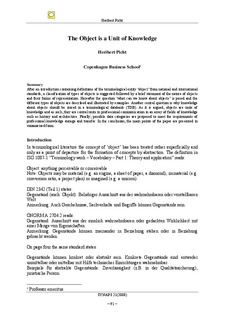| dc.description.abstract | After an introduction containing definitions of the terminological entity ‘object’ from national and international
standards, a classification of types of objects is suggested followed by a brief statement of the nature of objects
and their forms of representation. Hereafter the question ‘what can we know about objects’ is posed and the
different types of objects are described and illustrated by examples. Another central question is why knowledge
about objects should be stored in a terminological databank (TDB). As it is argued, objects are units of
knowledge and as such, they are central units in professional communication in an array of fields of knowledge
such as history and architecture. Finally, possible data categories are proposed to meet the requirements of
professional knowledge storage and transfer. In the conclusion, the main points of the paper are presented in
summarised form. | nb_NO |
